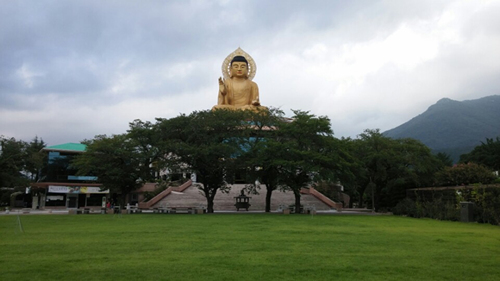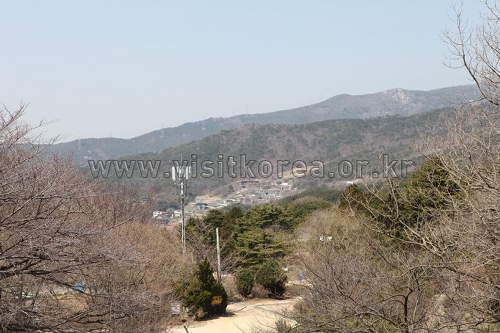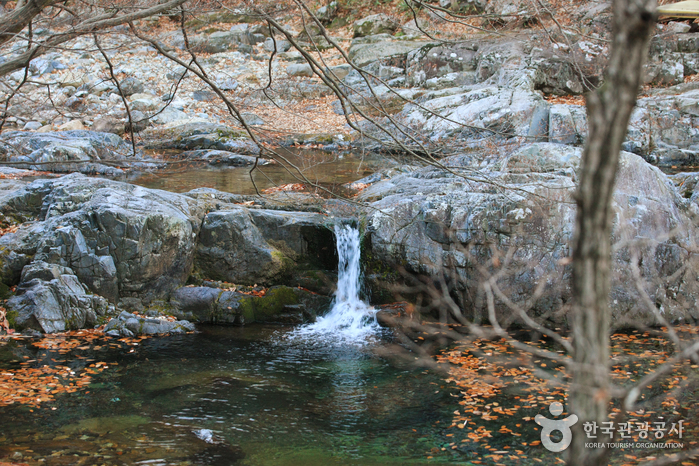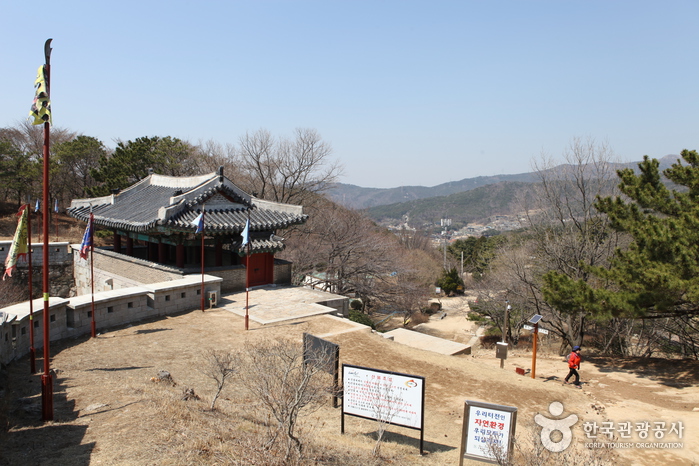Busan Hongbeopsa Temple (홍법사(부산))
8.5Km 2022-12-27
202, Dugu-ro 33beon-gil, Geumjeong-gu, Busan
+82-51-508-0345
Hongbeopsa Temple is located in Geumjeong dugu-dong, Busan and is known for the largest bronze Amida Buddha Statue in Korea at 21 meters. Surrounded by Cheolmasan Mountain and Geumjeongsan Mountain, a beautiful scenery stretching out to Suyonggang River makes one feel as if you were in Yeonhwajang, an ideal world in Buddhism that is filled with lotus flowers.
The temple has training rooms for visitors to practice meditation as well as a bust statue of Gandhi, donated by the Government of India to celebrate the 40th anniversary of diplomatic relationship between Korea and India. The temple has a wealth of attractions that cannot be seen in other temples of Korea such as huge statue of Buddha, India Cultural Center, Jeokmyeolbogung Palace, and beautiful gardens, luring an increasing number of tourists every year.
Eden Valley Ski Resort (에덴밸리스키장 (에덴밸리리조트))
9.3Km 2021-12-21
1206, Eosil-ro, Yangsan-si, Gyeongsangnam-do
+82-55-379-8000
Located in Yangsan, Gyeongsangnam-do, Eden Valley Resort ski slopes have been scientifically designed to disperse skiers and prevent overcrowding. Various slope types are available for skiers and snowboarders of diverse skill levels. Visitors can enjoy winter leisure sports in this international-standard ski resort.
Geumjeongsan Mountain (Busan National Geopark) (금정산 (부산 국가지질공원))
9.4Km 2019-11-20
Geumseong-dong, Geumjeong-gu, Busan
+82-51-888-3636
Geumjeongsan Mountain was created by an overflow of magma approximately 70 million years ago. Over time, rain and wind shaped the mountain to what it is now, with gentle slopes and unique rock formations. The mountain features various walking trails and historical attractions, such as Beomeosa Temple and Geumjeongsanseong Fortress.
Apgujeong Hanu Galbi (압구정한우갈비)
9.6Km 2024-02-26
61 Cheongnyong-ro, Geumjeong-gu, Busan
051-512-0025
Apgujeong Hanu Galbi is a restaurant renowned for its Korean beef galbi. The highlight of their menu is galbisal gui (grilled boneless galbi), notable for its tender meat and rich flavors. A simple seasoning of salt and pepper brings out its great taste. The restaurant also offers a selection of other beef cuts, including ribeye, marinated galbi, thin skirt, and whole galbi. Among the side dishes, dolsotbap (hot stone pot rice) stands out, offering freshly cooked rice with a savory, crispy layer of scorched rice at the bottom. Additionally, patrons have the option to enjoy their meal on the restaurant's terrace.
Naewonsa Temple (Yangsan) (내원사(양산))
9.9Km 2024-02-23
207 Naewon-ro, Habuk-myeon, Yangsan-si, Gyeongsangnam-do
Naewonsa Temple, situated in Cheonseongsan National Park, is home to a monumental Buddha statue standing at 5.5 meters, crafted during the Silla dynasty. The temple complex features various structures, including Bogwangjeon and Geungnakjeon Halls, showcasing its captivating architectural style. Renowned for its picturesque mountain landscapes and as a popular destination for autumn foliage, the temple attracts numerous visitors every year.
Naewonsagyegok Valley (내원사계곡)
9.9Km 2021-02-18
207, Naewon-ro, Yangsan-si, Gyeongsangnam-do
+82-55-380-4826
Naewonsagyegok Valley is located just below Naewonsa Temple at the foot of Cheonseongsan Mountain. The valley is surrounded by Jeongjoksan Mountain to the northeast, Wonjeoksan Mountain to the south, and Cheonseongsan Mountain to the southeast. The water running through the numerous valleys between these mountains has formed streams like Yongyeoncheon and Sangnicheon, which form the Yangsancheon Stream out of Naewonsagyegok Valley.
Naewonsagyegok Valley was formerly called Sogeumgang (little Geumgang), meaning that its beautiful scenery is comparable to that of the breathtaking Geumgangsan Mountain. It is also known as the “mystical valley” as crystal clear water flows all year round. The word “Sogeumgang” is distinctly engraved on one side of the cliff and large rocks stand in layers throughout the valley. Some of the rocks are called Byeongpungbawi Rock, literally meaning folding screen rocks, as they are stretched out much like folding screens.
The valley and the surrounding mountains are a popular summer vacation spot and a well-known hiking destination during the spring, fall, and winter. Muk (acorn jelly) made with acorns gathered from this area not only tastes great, but is also very healthy. Nearby attractions include Tongdosa Temple and Hongnyongpokpo Falls.
* Entrance into the upper region of Naewonsagyegok Valley is restricted.
Olive Young - Yangsan Deokgye Branch [Tax Refund Shop] (올리브영 양산덕계점)
10.3Km 2024-06-27
19, Beonyeong-ro, Yangsan-si, Gyeongsangnam-do
-
Wondong Recreational Forest (원동자연휴양림)
10.4Km 2024-02-23
69 Neulbat-ro, Wondong-myeon, Yangsan-si, Gyeongsangnam-do
Wondong Recreational Forest is situated where Gajisan Mountain – often referred to as the Alps of Korea – meets Yeongchuksan Mountain. It is celebrated for its breathtaking landscape, which includes valleys, dense forests, and waterfalls. This forest provides an ideal setting for forest bathing, allowing visitors to immerse themselves in nature along the crystal-clear waters of the valley, surrounded by unique rock formations. Additionally, with the largest campground in Wondong, the Wondong Recreational Forest attracts numerous tourists seeking a serene camping experience amidst natural beauty.
Geumjeongsanseong Fortress (금정산성)
10.6Km 2024-03-05
78-5 Bungmun-ro, Geumjeong-gu, Busan
+82-51-519-4092
Geumjeongsanseong Fortress, with a circumference of 18,845 meters along the ridges and valleys of Geumjeongsan Mountain, is a large-scale fortress built during the Joseon dynasty between 1701 and 1703. The fortress is accompanied by Geumjeongsanseong Village and is known for producing Sanseong makgeolli (unrefined rice wine), a traditional Korean alcoholic beverage. Additionally, there are numerous restaurants, cafés, and attractions, making it a place where nature, history, cuisine, and sightseeing coexist.
Himart - Deokgye Branch [Tax Refund Shop] (하이마트 덕계점)
10.6Km 2024-04-18
831, Ungsang-daero, Yangsan-si, Gyeongsangnam-do
-





![Himart - Deokgye Branch [Tax Refund Shop] (하이마트 덕계점)](http://tong.visitkorea.or.kr/cms/resource/24/2890024_image2_1.jpg)
 English
English
 한국어
한국어 日本語
日本語 中文(简体)
中文(简体) Deutsch
Deutsch Français
Français Español
Español Русский
Русский